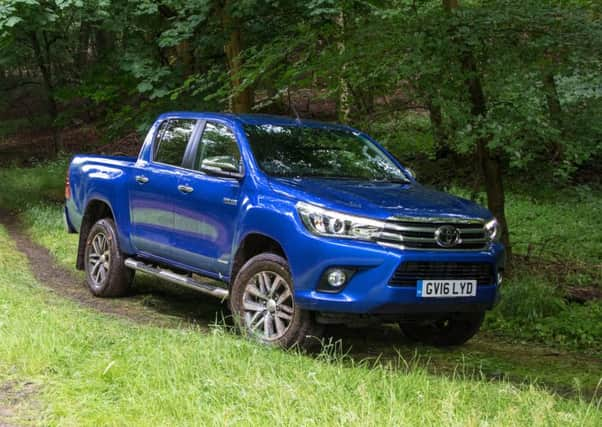Review: Toyota Hilux hasn't lost its bounce


Seen here is the latest Mk 8 double cab model in its super Hilux Invincible X version, costing from £33,765 with manual gears. Gone is the bluff front still found on its rivals. In comes a pointy snout with a long overhang and swept back headlamps and lashings of chrome. It looks more streamlined, for what that’s worth in pickup land.
The 3-litre diesel engine has been replaced by a 2.4-litre four-cylinder motor, rated as more powerful in torque but lower in horse power, and cleaner. This brings it into line with the opposition and may be a selling point to the grimy-gloved grafter and the general tradesman. The 0-62mph time is nudging 13 seconds.
Advertisement
Hide AdAdvertisement
Hide AdThe Hilux feels both dependable and ponderous. As a five-seater doing family duties it’s not my first choice. The ride and general feel are verging on agricultural – bouncy, noise, denying me confidence at speed in bends. The tailgate weight alone is massive, manageable to raise with one arm but much easier with two arms.
Toyota and Hilux people will respond that the truck’s principal role is earning its living, carrying loads, lugging trailers. There are more basic specifications for that (from £22,955 for the single cab Active) but Invincible X comes kitted out like a car inside with a glossy tablet information screen, quality plastics and upper and lower dash compartments with one locking. The load bed is lined with rock hard synthetics to shrug off hardcore loads. It is lettered Hilux across the tailgate. There’s a chromed roll-cage and side sill protectors incorporating useful steps. Each door pillar has a grab handle to help you board and get out easily and without a slip.
So it’s, as they say in the Camshaft Arms, a serious piece of kit. The average user should be OK with the Icon double cab, from £27,680. It has Toyota’s Touch2 multimedia system, powered retractable mirrors, DAB, rear view camera, cruise control, downhill crawling and 17-inch alloys. The Invincible from £29,850 adds 18-inch alloys, automatic air conditioning, pre-collision and pedestrian detection, LED headlamps, keyless entry and button ignition etc, while the Invincible X piles in with leather, an integrated media and navigation system on the tablet-like screen, parking sensors and so forth. All versions have 4x4 traction with a locking rear differential, trailer sway control, hill start assist, air con and a cooler box, heated mirrors and a tablet-like touch info screen.
My test car had the optional six-speed automatic gearbox, a fiddly dog-leg selector gate which was unnecessarily slow to use. A straight move between forward and reverse helps when the going gets tricky. The gearing per se has been revised and at times the gearbox was hunting for another ratio rather than settling into a lope – which is how the Hilux is best driven.
Forget anything like smart handling. In corners it gave little confidence unless driven with respect. So I settled into gentle driving, a workaday routine. Only when I filled it up with a load of sycamore logs did it begin to make sense. The ride improved, losing the bouncy, bouncy character when empty.
And here we come to the reason for a Hilux and rivals like the Isuzu D-Max and Ford Ranger. Their heavy duty suspension is primarily designed for carrying anything up to a ton and towing three tons and more. That’s also why they have an old-fashioned leaf sprung rear suspension – a contributor to their choppy ride. This system, one of the last descendants of the horse-drawn carriage, is tough, relatively cheap, and repairable in far-flung places.
The truck does its best to endear, with first person responses on screen, viz “I am calculating your fastest route” on the ultra smart info screen. It took me on a diversion around a big stoppage on the motorway and gave me a tour of the eastern roundabouts of Milton Keynes. I took its advice, having recently ignored a similar warning and lost 50 minutes.
The cabin is comfortable and roomy. There is the central box and two-tier dashboard compartments. Ideally, I’d like a dash-top compartment which is easier to reach when driving and fitted on the D-Max and the Nissan Navara NP300. In sunlight there are trim reflections in the door mirrors and various exterior reflections at night.
Verdict: Designed for hard work. Good economy in real life.